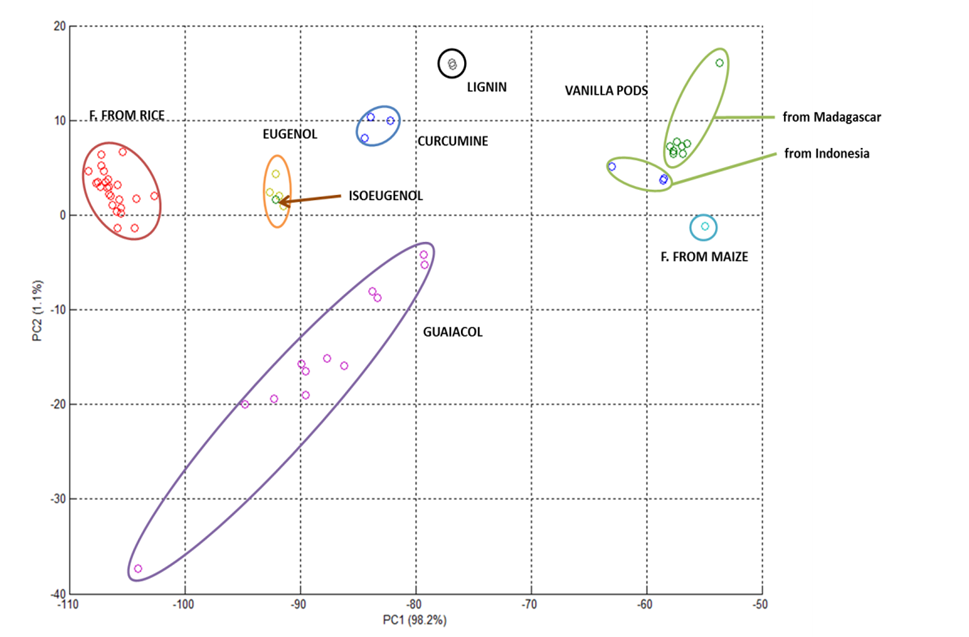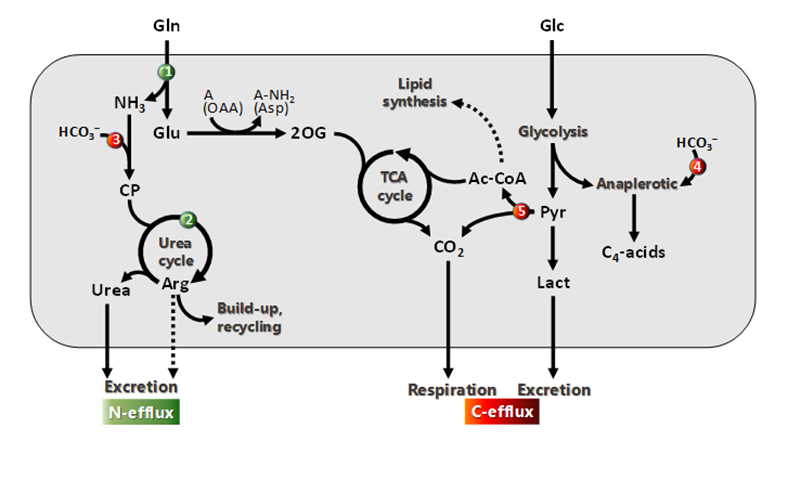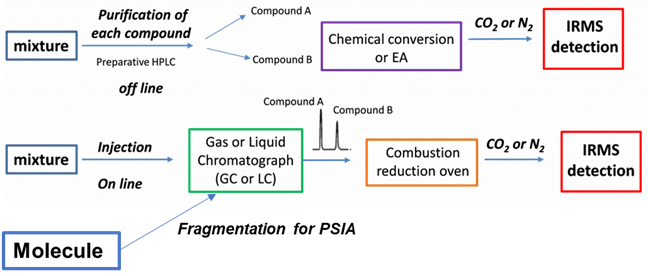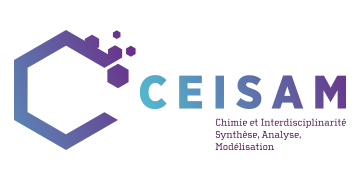Isotopic analysis at natural abundance has been a core expertise of our team since it was created in the 1980s by Profs. Martin and Martin, who discovered an original process based on SNIF-NMR to detect the chaptalization of wines.
Since then, we have made pioneering developments in this field, leading to a novel “isotopomics” approach, defined as the measurement of a large number of isotopic information at natural abundance, whether it is position-specific information obtained by NMR or average molecular information obtained by Isotope Ratio Mass Spectrometry (IRMS).
The innovative isotopic NMR developments carried out within the team, combined with recognized expertise in high-precision IRMS, enabled our team to target particularly original applications of isotopomics in food science, health, environment, forensics, health or metabolism.

Current team members: Margot Sanchez, Tania Mahnna, Anne-Marie Schiphorst, Virginie Silvestre, Mathilde Grand, Gérald Remaud, Serge Akoka*.
Past team members: Lenny Haddad, Sophie Renou, Vincent Portaluri, Ghina Hajjar, Denis Loquert, Eliot Botosoa, Didier Diomande, Alexis Gilbert, Sophie Guyader, Flore Legrand, Noelle Merchack, Richard Robins, Katarzyna Romek. Collaborations: J. Bejjani, T. Rizk (Saint-Joseph University, Beirut, Lebanon), F. Thomas, E. Jamin (EUROFINS, Nantes, France), P. Lesot (University of Paris Sud, Paris Saclay)

This project concerns the characterisation of food matrices, or psycho-active drugs, by the determination of the isotope profiles on targeted molecules or on the matrix itself (whole or a part). This isotopomics approach can be conveniently completed by other profiling such as metabolomics (see specific project). The interest of position-specific isotope analysis is demonstrated on ethanol and vanillin for which isotopic 13C NMR is enable to distinguish origins not discriminated by other methods. The geographical origins of olive oil or products from animal origin are also separated on basis of relative 13C profiles measured on the whole matrix thank to the capability of modified INEPT pulse sequence.
References:
- N. Merchak, V. Silvestre, D. Loquet, T. Rizk, S. Akoka, J. Bejjani. A strategy for simultaneous determination of fatty acid composition, fatty acid position, and position-specific isotope contents in triacylglycerol matrices by C-13-NMR. Analytical and Bioanalytical Chemistry, 2017, 409(1), 307-3015.
- T. Texier-Bonniot, P. Berdague, RJ Robins, GS Remaud, P. Lesot. Analytical contribution of deuterium 2D-NMR in oriented media to H-2/H-1 isotopic characterization. Flavour Fragrance J, 33, 217-229 (2018).
- V. Joubert, M. Trebuchet, M. Mikic, V. Silvestre, A.-M. Schiphorst, D. Loquet, A. Stemmelen, V. Ladroue, F. Besacier, S. Akoka, G. S. Remaud. Isotopomics by isotope ratio monitoring by 13C Nuclear Magnetic Resonance Spectrometry on cutting agents in heroin: a new approach for illicit drugs trafficking route elucidation. Drug Testing and Analysis, 12, 449-457 (2020).
- G. Hajjar, T. Rizk, J. Bejjani, S. Akoka. Metabisotopomics of triacylglycerols from animal origin: A simultaneous metabolomic and isotopic profiling using 13C INEPT. Food Chemistry 315 (2020)
- S. Akoka, G. Remaud. NMR-based isotopic and isotopomic analysis. Progress in NMR Spectroscopy, 120–121, 1–24 (2020).
- L. Haddad, S. Renou, G. S. Remaud, T. Rizk, J. Bejjani, S. Akoka. A precise and rapid isotopomic analysis of small quantities of cholesterol at natural abundance by optimized 1H-13C 2D NMR. Analytical and Bioanalytical Chemistry 413 1521–1532 (2021).
Supported by: National Council for Scientific research, University of Nantes National Council for Scientific research of Lebanon and Saint-Joseph University of Beirut
Current team members: Anne-Marie Schiphorst, Mathilde Grand, Gérald Remaud, Illa Tea*.
Past team members: Estelle Martineau, Julie Lalande, Maxime Julien, Richard Robins.
Collaborations (past and present): Sophie Barillé-Nion (CRCNA Nantes), Estelle Martineau (CEISAM, Univ Nantes), Anneke Blackburn (JCSMR, ANU, Canberra), Jane Dahlstrom (Canberra Hospital), Mikael Croyal (CRNH Nantes), Guillaume Tcherkez (RSB, ANU Canberra), José Hureaux (CHU Angers, MINT team), Regis Hankard (INSERM, Tours), Arnaud De Lucas (INSERM, Tours), Olivier Mantha (INSERM Tours)

There are important challenges: finding new treatments, improving diagnosis and cancer classification so as to anticipate treatment sub-type and life prognostic, and finding good markers to follow the response of cancer to treatment and anticipate cancer reactivation. Using stable (non-radioactive) isotopes at natural abundance (13C/12C and 15N/14N ratios), we have been the first to show that natural isotope abundance reflects cancer cell metabolism and that the isotope signature is a potential biomarker to differentiate normal and cancer cells and tissues.
Since cancer cells exchange nutrients and waste products with blood, we anticipate that isotopic differences should be detectable in some plasmatic metabolites. Therefore, we intend to carry out a biomarker discovery process by which we will elaborate on our preliminary findings, and identify candidate isotopic biomarkers. The ultimate aim is to find avenues to develop a blood test for cancer detection and thus patient screening, and to monitor cancer patients for the recurrence of disease, detecting it earlier and improving their treatment outcomes.
Recent References
- O.L. Mantha, R. Hankard, I. Tea, A-M. Schiphorst, J-F. Dumas, V. Berger, C. Goupille, P. Bougnoux, A. De Luca, N-3 Fatty Acid Supplementation Impacts Protein Metabolism Faster Than it Lowers Proinflammatory Cytokines in Advanced Breast Cancer Patients: Natural 15N/14N Variations during a Clinical Trial. Metabolites (2022), 12(10):899
- I. Tea, A. De Luca, A.M. Schiphorst, M. Grand, S. Barillé‐Nion , E. Mirallié, D. Drui, M. Krempf, R. Hankard and G. Tcherkez , Stable Isotope Abundance and Fractionation in Human Diseases. A review. Metabolites (2021), 11, 370
- A.Kuster , I. Tea , D. Darmaun , J-C. Rozé , R. Robins ,R. Hankard, Plasma amino acid pools in the umbilical cord artery show lower 15N natural isotope abundance relative to the maternal venous pools. Isotopes Environ Health Stud (2021),1:3-10
- A. De Luca, O.L. Mantha, J.-F. Dumas, C. Goupille, RJ. Robins, I. Tea, P. Bougnoux, R. Hankard, S, Effect of a 10-day fish or copra oil oral nutritional supplementation on plasma bulk 15N and 13C natural isotopic abundances in women with metastatic breast cancer. Clinical Nutrition ESPEN (2020), 40, 54
- DD.Tian, S K. Bennett, LA. Coupland, K. Forwood, Y. Lwin, N. Pooryousef, I. Tea, TT. Truong,T. Neeman, P. Crispin, J. D’Rozario, AC. Blackburn, GSTZ1 genotypes correlate with dichloroacetate pharmacokinetics and chronic side effects in multiple myeloma patients in a pilot phase 2 clinical trial. Pharmacol Res Perspect. (2019), 7(6):e00526
Supported by: Région Pays de la Loire (PLAISIR project Association for International Structure), Canberra Hospital (Private Practice Fund), French Funding from University Technology Transfer Services, Australian National University ANU, French Funding for international cancer research ‘Fondation de France’, CHU Angers, Australian National University ANU
Current team members: Anne-Marie Schiphorst, Mathilde Grand, Gérald Remaud, Illa Tea*
Collaborations : Guillaume Tcherkez (RSB, ANU Canberra)

Overview of instrumental coupling for compound specific isotopic analysis (CSIA) and position specific analysis (PSIA), performed using off-line (A) & on-line methods (B)
The natural isotope abundance in bulk organic matter or tissues is not a sufficient base to investigate physiological properties, biosynthetic mechanisms, and nutrition sources of biological systems. In fact, isotope effects in metabolism lead to a heterogeneous distribution of 2H, 18O, 13C, and 15N isotopes in metabolites. Therefore, compound specific isotopic analysis (CSIA) and intra is crucial to biological and medical applications of stable isotopes. We are exploring CSIA extended to other molecules (such as xanthines, fatty acids, arginine which is a good candidate for breast cancer biomarkers) and elements such as oxygen and hydrogen (still in its infancy in biology and medicine) and sulphur (nearly nonexisting currently).We are also developing an innovative approach for 15N-PSIA. To do so, the project includes an industry partner (IRMS manufacturing company, Elementar). This powerful IRMS method, leads to valuable information on 15N site-specific isotope fractionation in complex mixtures, thus offering biologists a new biomedical tool to understand metabolic and physiological pathways
Key References:
- D. Diomandé, T.T. Dro, J.S. Akpa, V. Silvestre, I. Tea, G.S. Remaud. Quantitative Measurement of the Chemical Composition of Fatty Acid of Cocoa Butter and the Isotopic Content of Glycerol Contained in Cocoa Butter by the NMR 13C from the INEPT Sequence and Characterization of the
Geographical Origin of the Cocoa Origin American Journal of Analytical Chemistry 13 (2022), 79-95 - Diomandé, A. Kouassi, J.S. Akpa, I. Antheaume, I. Tea, G.S. Remaud. Use of the 13C/12C, 15N/14N and 18O/16O Isotopic Ratios of Theobromine and Caffeine in the Characterization of Geographic Origin American Journal of Analytical Chemistry 12 (2021), 87-95
Supported by: Australian National University ANU, University of Nantes, Région Pays de la Loire and Angers Loire Métropole via the research grant Connect Talent Isoseed, the French Regional Hospital Program for Clinical Research, the CNR Défi Isotop, ANR PRCE (under contract ANR-20-CE18-0020-03), MetaboHUB-ANR-11-INBS-0010
